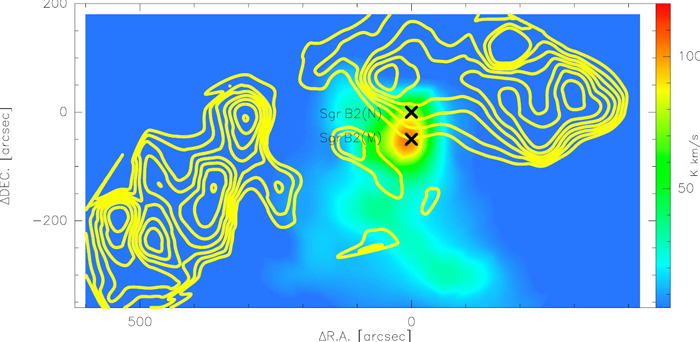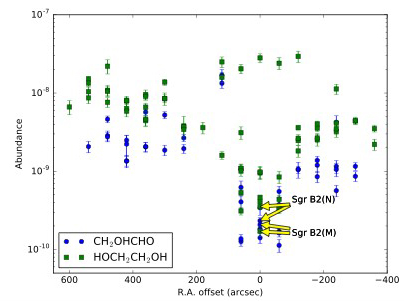Complex organic molecules (COMs) are directly related to the origin of life on the Earth, thus understanding the property and formation mechanism of prebiotic molecules is key to study of astrobiology. Observations indicate that COMs are abundant in Galactic center giant molecular cloud Sagittarius B2 (Sgr B2). Sgr B2(N), the main site of star-formation site in Sgr B2, is long believed to be the best target for search of COMs in the interstellar medium (ISM). Most COMs, including glycolaldehyde and ethylene glycol, were detected in Sgr B2(N) for the first time. Glycolaldehyde, which is the simplest sugar-related molecule, can react with propenal to form ribose - a central constituent of RNA. Ethylene glycol, is a dialcohol, which is commonly known as an antifreeze coolant for car engines. Both of these two molecules are important COMs, however, the exact extent of glycolaldehyde and ethylene glycol in the Galactic center still remains unclear.
Using Shanghai Tian Ma Radio Telescope (TMRT), a 65 meter diameter fully-steerable radio telescope located in the western suburbs of Shanghai, China, a team led by Prof. Zhiqiang Shen from Shanghai Astronomical Observatory (SHAO) carried out mapping observation of glycolaldehyde and ethylene glycol in Sgr B2 with 200 hrs observing time. They found that the spatial distribution of these two molecules are very extended in Sgr B2, with an angular size of about 15 arcmin, or a linear size of about 100 light-year (see Figure 1). The mass of glycolaldehyde is estimated to be about 10,000 times of Earth’s mass, indicating that there are abundant complex organic molecules in the Galactic center.

Figure 1 Integrated intensity map of glycolaldehyde (upper panel) and ethylene glycol (lower panel) emission observed toward Sgr B2 overlaid on H78alpha emission in color scale. Two crosses are used to denote positions of Sgr B2(N) and Sgr B2(M), two main sites of star-formation in Sgr B2.
TMRT team found that these two molecules distributed not just around hot core with active star-formation activity, but also in quiescent regions without significant star-formation activity. The abundance of these two molecules decrease from quiescent regions to star-forming regions (Figure 2). Combined with theoretical and experimental chemistry studies, the TMRT results suggest that these two molecules likely form through hydrogen reaction of CO on ice surface under low-temperature. The extremely complicated physical environment of Galactic center, including large-scale shocks and abundant cosmic-rays, released these molecules to gas from ice surface. These observing results raise a question to us: are complex organic molecules abundant in the interstellar surface? If so, these molecules could be transferred to planet, and provide abundant materials for the origin of life. Future infrared telescope like James Webb Space Telescope could help answer these questions through high sensitivity observations of ice constitutes.

Figure 2 Variation of glycolaldehyde (circles) and ethylene glycol (squares) abundance with R.A. offset away from Sgr B2(N). Results of Sgr B2(N) and Sgr B2(M) were labeled in the figure.
Link to the research paper:http://arxiv.org/abs/1709.10247
Other reports: https://phys.org/news/2017-10-glycolaldehyde-ethylene-glycol-sagittarius-b2.html
Science Contact:
Juan Li, Shanghai Astronomical Observatory, lijuan@shao.ac.cn
Zhiqiang Shen, Shanghai Astronomical Observatory, zshen@shao.ac.cn
News Contact:
Wenwen Zuo, Shanghai Astronomical Observatory, wenwenzuo@shao.ac.cn

